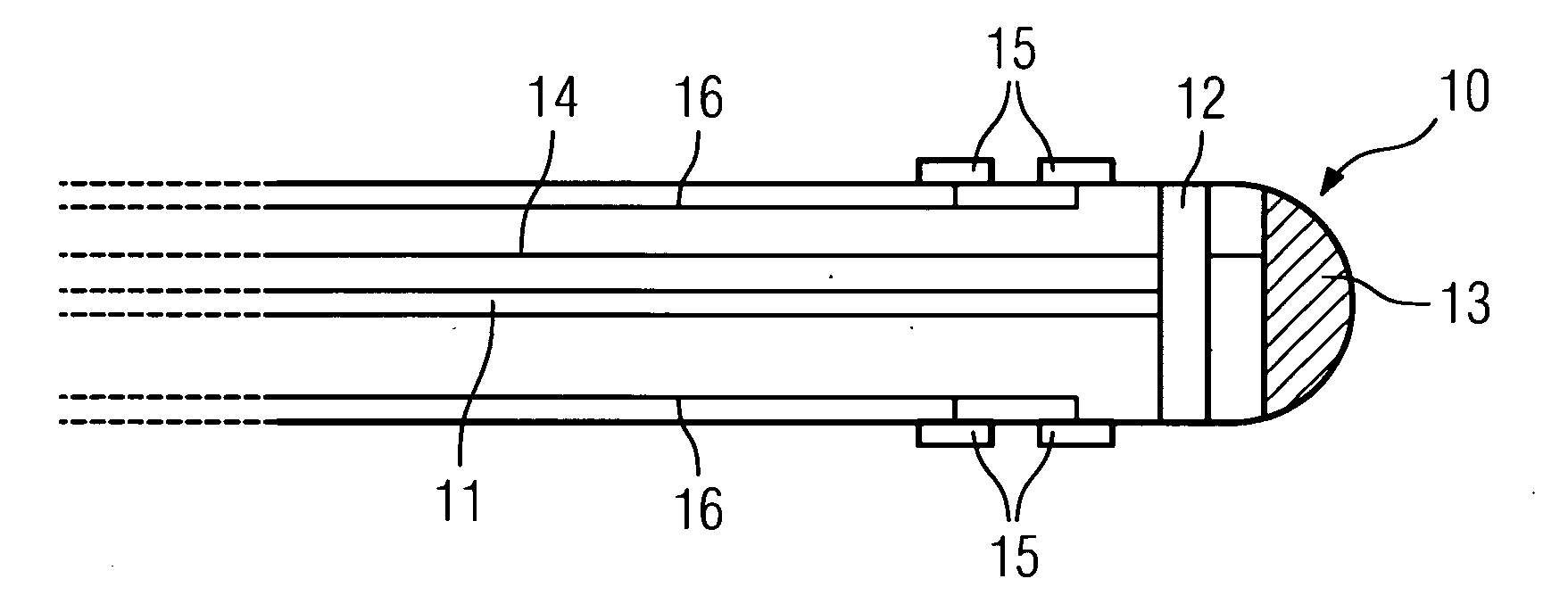Catheter device
a catheter and tube technology, applied in the field of catheters, can solve the problems of atrial flutter, negative affecting the stimulus conduction capability of the ventricle myocardium, etc., and achieve the effect of simple fashion and safe and purposeful working
- Summary
- Abstract
- Description
- Claims
- Application Information
AI Technical Summary
Benefits of technology
Problems solved by technology
Method used
Image
Examples
first embodiment
[0032] In the exemplary embodiment, FIG. 2 shows the tip 10 of a catheter of a first embodiment in detail. A thin optical fiber guide 11 is shown, via which the light on which OCT imaging is based is supplied, or the recorded reflected light is coupled out. The light is supplied and the decoupled light is processed using the device 3. A window 12 in the region of the tip of the catheter is provided for this purpose, from which the light is coupled out vertical to the longitudinal axis of the catheter. To this end the optical fiber guide 11 is designed accordingly, as is known. The decoupled light beam rotates, so that an annular image of the area adjacent to the tip is captured.
[0033] An ablation electrode 13 is further provided, which is fed via a power feed line 14. This enables adjacent tissue to be necrotized using high-frequency pulses of current.
[0034] Furthermore a plurality of electrodes 15 is provided, which are arranged on the outside of the catheter and can be controlled...
second embodiment
[0036]FIG. 3 shows another tip 17 of the catheter of a Here too an optical fiber 18 is provided, but it is a fiber bundle of many individual light guides rather than a single fiber. The light is coupled in and out via an OCT lens 19 arranged in the tip in the longitudinal direction of the catheter. Upstream of this is a collimator 20, which ensures that the light emitted by a fiber was reflected precisely to the one from which the light was emitted. This ensures that the OCT imaging is not impaired with this type of “longitudinal coupling in and out”.
[0037] Otherwise electrodes 20 and the ablation device 21 are also provided, the latter being positioned laterally here. Different local positioning options are of course also conceivable here.
[0038] Finally FIG. 4 shows another tip 22 of the catheter. In this case, instead of an OCT imaging device an ultrasound device comprising an ultrasonic head 23 arranged in the tip with a corresponding signal line 24 is provided, via which ultra...
PUM
 Login to View More
Login to View More Abstract
Description
Claims
Application Information
 Login to View More
Login to View More - R&D
- Intellectual Property
- Life Sciences
- Materials
- Tech Scout
- Unparalleled Data Quality
- Higher Quality Content
- 60% Fewer Hallucinations
Browse by: Latest US Patents, China's latest patents, Technical Efficacy Thesaurus, Application Domain, Technology Topic, Popular Technical Reports.
© 2025 PatSnap. All rights reserved.Legal|Privacy policy|Modern Slavery Act Transparency Statement|Sitemap|About US| Contact US: help@patsnap.com


